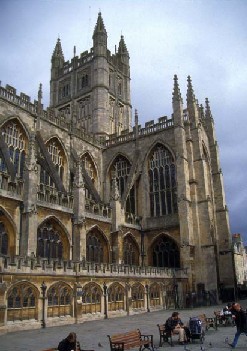|
|
|
| Home | Roman Bath | Dark Ages | Middle Ages | Upheaval | Georgian | Nineteenth century | Twentieth century | Twenty first century |
Bath in the Dark Ages 500-1000AD |
The missing centuries |
 Fable: The wall in the forest Fable: The wall in the forest
I went further today than I had done since first I entered the forest. I found something, a wall, of a strange kind, but undoubtedly a wall. It lay straight in my path as I pulled sticks from the edge of a clearing. My clearing, in fact - the sum of a few days' work in this region, and work which has pleased my father no end. He sends me back again and again into this new part of the forest, praising me for my hard work. It is only so he can spend more time with my new Mother, who is just my age, but I don't mind, because it lets me roam in a way I haven't since my first Mother died... |
After the Roman withdrawalThe Romans drew back from Britain and their most north-easterly province some time in the fifth century, and the heart of Bath fell into disprepair. The lower parts of the town flooded regularly, and silt and dirt flowed from the Avon to cover the bathing complex. Some few of the Roman settlers - by now integrated with the native population - remained in the area, perhaps living within the walled and ramparted city, but also in the Walcot area to the north. Gradually, Bath was literally dismantled - not in an attack, but over many years, its stones removed for new buildings elsewhere.
|
|
|
 This
photo: I broke the rules and got it from the web. I believe it's the 1930s,
Orange Grove. Incidentally, those 'shells' over the windows are not that
old - turn of the last century or so. The houses, however, are
Georgian - or at least, the basis of them is. And the Huntsman pub
just roud the corner has the oldest shop-front in Bath. Check out the
ornate stnework over the windows. Bizarre. But most photos on this site
are taken by me, as you can no doubt tell from the quality. - Archsweet
This
photo: I broke the rules and got it from the web. I believe it's the 1930s,
Orange Grove. Incidentally, those 'shells' over the windows are not that
old - turn of the last century or so. The houses, however, are
Georgian - or at least, the basis of them is. And the Huntsman pub
just roud the corner has the oldest shop-front in Bath. Check out the
ornate stnework over the windows. Bizarre. But most photos on this site
are taken by me, as you can no doubt tell from the quality. - Archsweet
Abbey photos: thanks to the photographer Ian Britton and his pictures of Bath
at:
![]()
This page last updated: 21 February, 2001
| Home | Roman Bath | Dark Ages | Middle Ages | Upheaval | Georgian | Nineteenth century | Twentieth century | Twenty first century |